General Description of the Department
The department was founded by Professor Shoji Kume in April 1991. His successor Professor Yukio Ozaki has been in charge of educational and research activities of the department since April 1997. We seek to give medical students fruitful education related to laboratory medicine so that they will be able to reach appropriate diagnosis and treatment plans. We hope to make contributions to the advancement of medicine through research and development of laboratory procedures, investigation and evaluation of clinical significance of laboratory tests, and better understanding of pathogenesis. Secondly, we focus on maintaining the level of our services as the central laboratory unit at a high level. Since our service is to provide laboratory data on patients by which diagnosis and therapy are based upon, it is our duty to supply accurate test results to the clinical staff. Furthermore, we are also involved in the states-of-the-art research related to the mechanism of thrombus formation, with special emphasis on the roles of platelets and vascular endothelial cells.
Members of Faculty
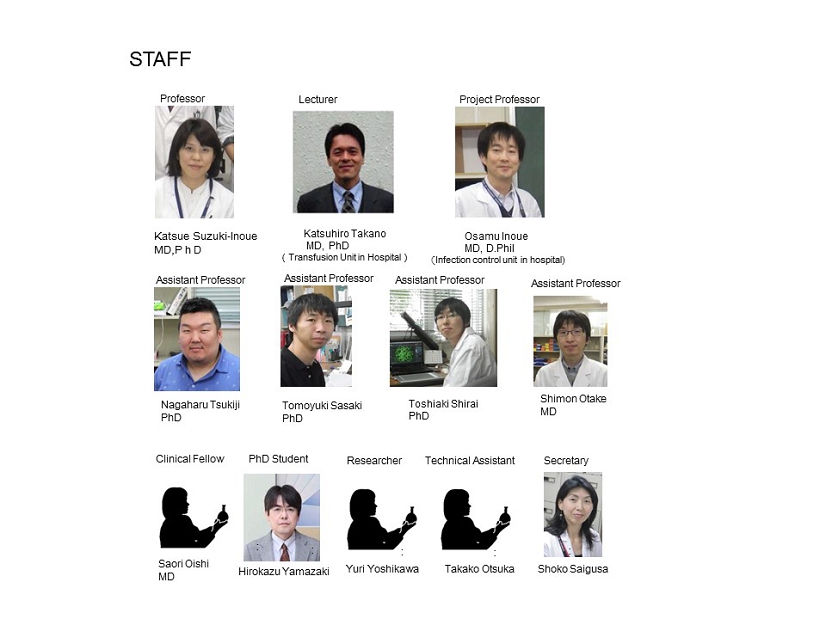
 General Description of Research Activities
General Description of Research Activities
The department conducts research on thrombosis and haemostasis with particular references to blood platelets and vascular endothelial cells. The followings are our main research projects:
1. Detection of the activated state of platelets
2. Monitoring of anti-platelet therapy
3. Unraveling the mechanism of platelet activation, particularly those related to tyrosine phosphorylation
4. Finding and characterizing a novel platelet-activating receptor that plays a role in thrombosis and haemostasis
Platelets play a central role in the mechanism of the primary phase of haemostasis in cases of vascular damages, and they are also involved in the development of pathologic thrombus formation and arteriosclerosis. It follows that qualitative and quantitative evaluation of platelet function and detection of the activated state of platelets in vivo are important challenges in clinical medicine. Another problem in clinical and laboratory medicine is that we still do not have ideal method for monitoring the effect of anti-platelet drug, although a number of patients undertake anti-platelet therapy. Therefore, we are seeking a new laboratory test for monitoring anti-platelet therapy.
Platelets are activated with various stimuli, and full platelet activation requires the interaction between receptors and ligands on the platelet membrane and subsequent activation of intracellular signal transduction pathways. We and others have found that the signaling molecules related to protein tyrosine phosphorylation play pivotal roles in many aspects of platelet activation, and we are currently seeking to identify the molecules involved in these processes and to investigate their functional significances.
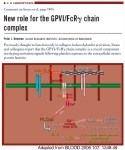
The interaction between von Willebrand factor (VWF) and collagen, one of the major subendothelial matrices is the most initial step in the process of haemostasis at sites of
vascular injury. The conformational change of VWF leads its binding to GPIb, a major glycoprotein on the platelet membrane, which leads to platelet adhesion on the damaged blood vessels. Collagen-VWF-GPIb interaction allows a potent collagen receptor GPVI to interact with exposed collagen, which results in robust platelet activation, leading to platelet aggregation. While this paradigm 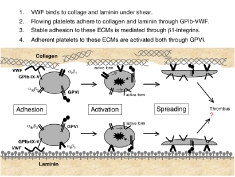 of the biological processes involving collagen-VWF-GPIb and collagen-GPVI interactions has been well established, we have found that there is another important paradigm, involving laminin-VWF-GPIb and laminin-GPVI interactions. This epoch-making finding was introduced in a commentary in Blood. (Inoue, O. et al. Laminin stimulates spreading of platelets through integrin alpha6beta1-dependent activation of GPVI. Blood. 2006; 107(4):1405-1412; Inoue O, Suzuki-Inoue K, Ozaki Y. Redundant mechanism of platelet adhesion to laminin and collagen under flow: involvement of von Willebrand factor and glycoprotein Ib-IX-V. Journal of Biological Chemistry. 2007; 283(24):16279-16282). A model of the platelet interaction with laminin at the sites of damaged vessel wall is shown on the left.
of the biological processes involving collagen-VWF-GPIb and collagen-GPVI interactions has been well established, we have found that there is another important paradigm, involving laminin-VWF-GPIb and laminin-GPVI interactions. This epoch-making finding was introduced in a commentary in Blood. (Inoue, O. et al. Laminin stimulates spreading of platelets through integrin alpha6beta1-dependent activation of GPVI. Blood. 2006; 107(4):1405-1412; Inoue O, Suzuki-Inoue K, Ozaki Y. Redundant mechanism of platelet adhesion to laminin and collagen under flow: involvement of von Willebrand factor and glycoprotein Ib-IX-V. Journal of Biological Chemistry. 2007; 283(24):16279-16282). A model of the platelet interaction with laminin at the sites of damaged vessel wall is shown on the left.
Increasing bodies of evidence suggest that there are unknown platelet activationreceptor(s) on platelet surfaces that contribute to thrombosis and haemostasis.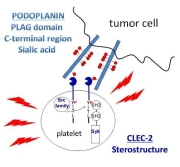
We identified a novel platelet activating receptor, c-type lectin-like receptor 2 (CLEC-2) as a receptor for the snake venom rhodocytin (Suzuki-Inoue, et al. A novel Syk-dependent mechanism of platelet activation by the C-type lectin receptor CLEC-2. Blood. 2006; 107(2):542-549). After pains-taking efforts, we pinpointed the physiological ligand for CLEC-2, which was podoplanin, a sialoglycoprotein present in podocytes, tumor cells, and lymphatic endothelial cells. (Suzuki-Inoue K, et al. Involvement of the snake toxin receptor CLEC-2, in podoplanin-mediated platelet activation, by cancer cells. Journal of Biological Chemistry. 2007; 282(36):25993-26001, Papers of the Week).
We have also succeeded in producing CLEC-2 knockout mice, and found that they are lethal at the fetal stage due to impaired separation of lymphatic vessels from veins,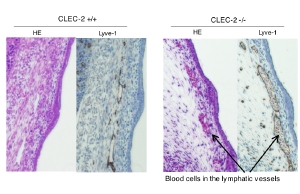 demonstrating that CLEC-2 on platelet membrane regulates lymphatic/blood vesselformation. (Suzuki-Inoue K, et al. Essential in vivo roles of the c-type lectin receptor CLEC-2: Embryonic/neonatal lethality of CLEC-2-deficient mice by blood/lymphaticmisconnections and impaired thrombus formation of CLEC-2-deficient platelets. Journal of Biological Chemistry, in press)
demonstrating that CLEC-2 on platelet membrane regulates lymphatic/blood vesselformation. (Suzuki-Inoue K, et al. Essential in vivo roles of the c-type lectin receptor CLEC-2: Embryonic/neonatal lethality of CLEC-2-deficient mice by blood/lymphaticmisconnections and impaired thrombus formation of CLEC-2-deficient platelets. Journal of Biological Chemistry, in press)
General Description of Educational Activities
Through our clinical training, medical students need to acquire adequate knowledge of each clinical and laboratory test and the ability to choose appropriate methods, interpretation of the results, diagnosis, and treatment based on evaluation of laboratory tests. For that purpose, we offer classes to students on general theory of clinical and laboratory medicine, and we give detailed explanations on basic test techniques during courses. In the fifth year, we provide clinical training at the hospital in groups of two to six students. They perform various measurements by themselves (blood drawing, electrocardiograms, urinary sediment, white blood cell differentiation, biochemical tests) using mainly their own samples, so that they can acquire fundamental techniques and improve their ability in interpreting and evaluating test data.
 ホーム
ホーム 前のページへ
前のページへ